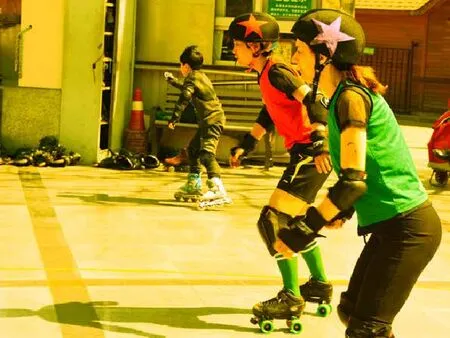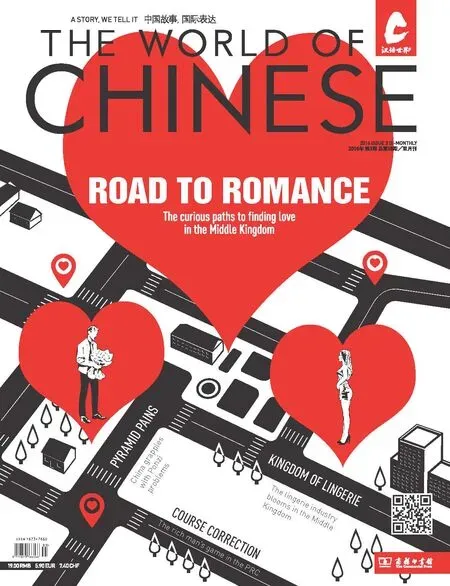HOW THEY ROLL
BY DAVID DAWSON
HOW THEY ROLL
BY DAVID DAWSON

Jammers from each side skate during a training exercise in Tuanjiehu, Beijing, April 2016
Wheels in motion as roller derby gains foothold in China
七八十年代兴起的滑旱冰,如今又有了新花样,
来一场女子“轮滑德比”,体验速度与力量
Every Saturday in Beijing’s Tuanjiehu Park, at a skating rink a stone’s throw from waterslides and dancing grannies, roughly a dozen skaters gather to hone their rollerderby skills. In May they face off against a team from Thailand in what will be the first international game for Beijing’s core group of around 20 skaters.
On this particular Saturday, in the dry warm weather of Beijing spring,an eclectic mix of expats and locals are trying to hone their blocking skills in particular, while also showing some new referees the ropes. Shouts of“arm check” and “no pack” can be heard, along with repeated whistles. Staying within the perimeter is not an easy task and referees have to be on the ball—but, of course, there is no ball.
Each team has a “jammer” who isbasically trying to do circuits of the arena and lap the jammer from the other team. The rest of the players are “blockers” trying to prevent the opposing jammer from succeeding,often by forming a barrier with interlinked arms. There are extensive rules on what kinds of blocks are permitted (elbow-blocks are a constant source of penalty whistles from referees) and players are required to wear a great deal of safety gear.
“I LIKE IT BECAUSE YOU CAN FEEL THE WIND WHEN YOU SKATE, AND THERE’S A REAL
SENSE OF TEAMWORK”
Roller derby is in many ways an unusual sport for China; not only is it very much a contact sport, but most of the players are female. This is part of the reason why the May bout against Thailand is part of the “HeforShe” UN gender equality project. The sport is so new in China there isn’t an agreed-upon term that the average Chinese person on the street would recognize. Borrowing from English and the few references found in media,the Beijing Roller Derby group is going with the Chinese term “轮滑德比”(lúnhuá débǐ) which uses the Chinese term for skating along with a phonetic approximation of “derby”.
Beijing Roller Derby, founded in 2013, is not the only roller derby group in China—Hong Kong and Shanghai both have their own leagues as well.
Persuading Chinese (or most people for that matter) of any gender to play a contact sport on roller skates is a big ask, given the fear of injury, but it hasn’t dissuaded skaters like Emily Zhang. “To be honest, I do worry a bit about getting hit, which is why I prefer to be a blocker rather than a jammer,” she says.
“I was introduced to the sport by an Australian friend...I had to learn to skate first, and I was always falling down but after a few months I improved,” she says. “I like it because you can feel the wind when you skate,and there’s a real sense of teamwork. There’s a sense of belonging, and you’re part of a community.”
One of the other Chinese players,Ella Zhang, however, has a different stance of the contact element of the sport. “I like to be a jammer” she says,smiling. They both admit however,that the sport can be incredibly tiring and that injuries are not uncommon despite the extensive safety gear. With practice and proper form, however,the risks decrease.

players wait for a jam (the two minutes when a jammer attempts to pass the blockers)
Roller derby is the newest form of roller skating in China. Roller skateshave most likely had a presence in the country since the 70s, though it’s not a topic that interests Chinese historians who by-and-large have little incentive to focus on pop culture as there is far more prestige in writing on the dynastic squabbles of ages past. Certainly, roller skating would have had no place during the wild years of the Cultural Revolution,but photographs of roller skaters dating back to the 1980s can be found online, along with comments suggesting it had a presence in the 70s—particularly in the frigid regions of Northern China where people were already accustomed to ice skating. Even the name for roller skating, “滑旱冰”, translates to“skating on dry ice.”

The jammer, marked with the star headgear, attempts to pass a wall of blockers
Rollerblading (直排轮滑) came of age in the 1980s and is now more popular than roller skating,though both kinds of footwear can be found on skaters of all ages enjoying outdoor rinks in parks throughout the country. It has also made occasional waves in pop culture; in 2010, 30-year-old Henan native Cao Hongwei made headlines when he began a three-year (split into three phases with breaks in-between) trip across China on rollerblades. During that time, he encountered sandstorms, obstructive police, and altitude sickness, but persevered. By the end of 2012 he had skated through 286 cities, with the financial cost of all three years of skating coming to just 20,000 yuan.
While his determination impressed readers,even greater attention came with the exploits of Feng Hui, who in 2011, when she was just 12 years old, won the Freestyle Roller Skating Grand Prix in Shanghai and in 2013 won three gold medals at a skating event in Paris. In 2014,a clip of her (filmed at the 2011 Shanghai event)went viral, showing her impressive skating performance in time with Michael Jackson’s“Beat It”.
With Asia’s first international roller derby competition just completed and increasing numbers of young Chinese looking for alternative forms of exercise, it seems likely that the skating rinks that populate parks throughout the country are going to see extensive usage for some time yet.

